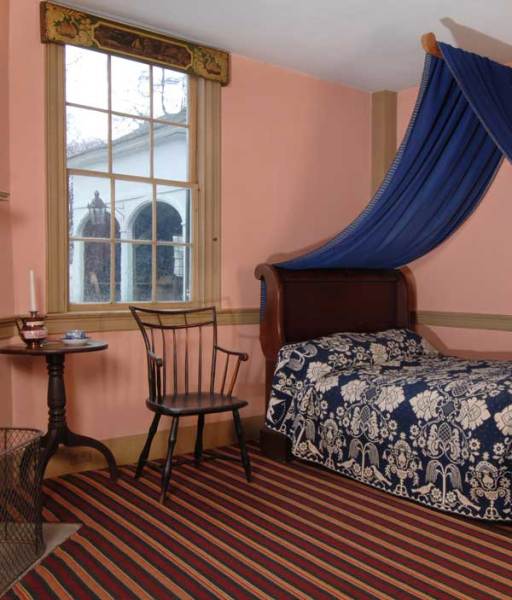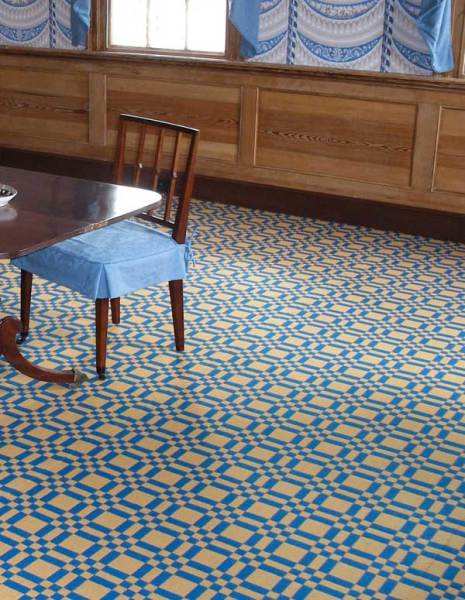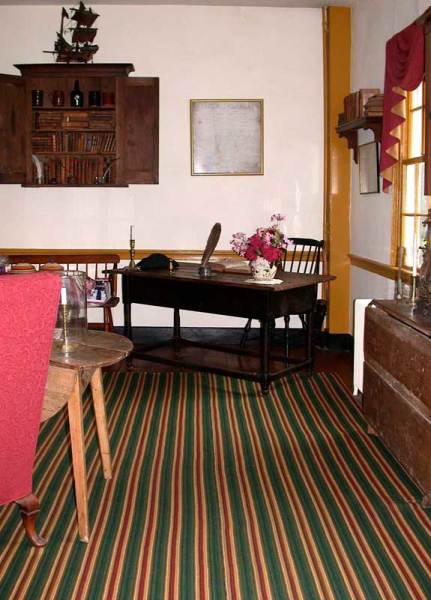
Vivid color in a striped Venetian wool carpet at the Bump Tavern, part of the Farmers’ Museum at Cooperstown, New York. (Photo: Richard Walker)
When we examine probate inventories taken in the English and Dutch settlements of 17th-century New York, one item we see repeatedly is “green carpet.” Now, the inventories are skimpy on detail, so we don’t know if these green carpets were used on beds, on tables, or on floors. We do know that they were made of wool and performed a valuable role from the time of earliest European settlement. Our ancestors understood that wool carpets added beauty and warmth to their homes. What they may not have known is something increasingly important to us today: that wool carpet is a “green” choice—that is, it’s environmentally friendly.
Wool is sustainable.
Wool has always been a “green” product. During the colonial and Federal periods, in rural areas, locally raised wool was used at home to provide blankets, stockings, sheets, and some undergarments. It also was spun and sent to the local weaver to produce Venetian and striped carpet, and ingrain carpet.

Geometric ingrain carpet in Athens, Georgia.
Today, sheep are raised all over the world, in many different climates. Because sheep are adaptable and reproduce so readily, wool is the ultimate renewable resource. (And of course, sheep can be sheared repeatedly in their lifetimes.) Unlike cotton, wool does not require large amounts of water or pesticides to produce. Bamboo, often touted as a new “green” fiber, requires toxic chemicals to process it into useable fiber; wool does not.
Wool can be dyed with low-impact, environmentally friendly dyes that do not contain heavy metals. Since a variety of sheep produce wool that can be used effectively in carpets, production of wool carpeting can help maintain a diverse animal population, promoting healthy biodiversity. Finally, wool has a smaller carbon footprint than manmade carpet fibers such as nylon and polypropylene, which are petroleum-based.
Wool is “good for you.”
Recent research demonstrates that wool is not just “good for the planet”—it’s good for you. Studies conducted by the University of Sydney, the Swedish Textile Research Institute, and the Wool Research Organization of New Zealand show some of the amazingly green qualities of wool carpet.

A geometric ingrain carpet in four colors installed wall-to-wall in a historic Federal-period mansion in Hudson, New York. The wallpaper was hand block-printed by Adelphi Paper Hangings. (Photo: Richard Walker)
For example, wool carpets trap airborne pollutants and irritating particulate matter, including formaldehyde, nitrogen dioxide, and sulfur dioxide, effectively trapping them for up to 30 years. Thus, wool carpet actually helps clean the air in your home.
Wool also helps control humidity. Because wool can absorb up to 30 percent of its weight in water and still feel dry, it pulls excess moisture out of the air when conditions get too humid. It also releases moisture when conditions get too dry, in cold areas where central heating can cause damage to sensitive breathing passages or even furniture and woodwork. A variety of studies show that ambient relative humidity is maintained at a much more even and healthy level where wool carpeting is in place.
Even the size of wool fibers is good for you: They’re too large to become lodged in airways. Unlike other fibers, wool does not cause irritation in people with asthma and other breathing difficulties.
Early Americans knew that wool retards fire, which is why they put wool rugs in front of their hearths to protect their furnishings and their houses. Another advantage is that wool carpet muffles sound and acts as an insulator, making your home feel warmer.

Wool’s structure makes it uniquely suited to carpet. Move furniture, and fibers spring back.
Wool is durable.
The structure of wool makes it uniquely suited to carpet. The arrangement of cells and the structure of its proteins make wool springy, which means that you can set a sofa, piano, table, or chair on a well-woven wool carpet, and the carpet will spring back when you move the furniture months or even years later.
When we re-create period rooms, we pay attention to the new research. But we also take into consideration the comfort of our living environment. We want our choices to be historically accurate, but we also want to be sensitive in our purchasing. From a weaver’s point of view: Use wool! It’s been a good choice for centuries.
For sources, see the Products & Services Directory.







